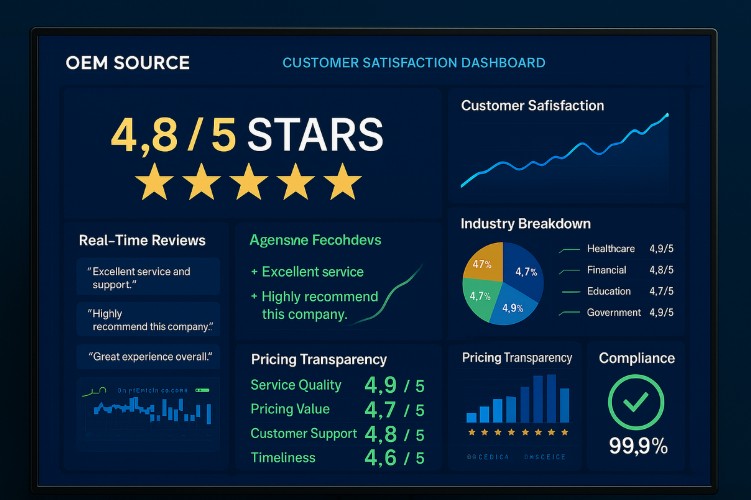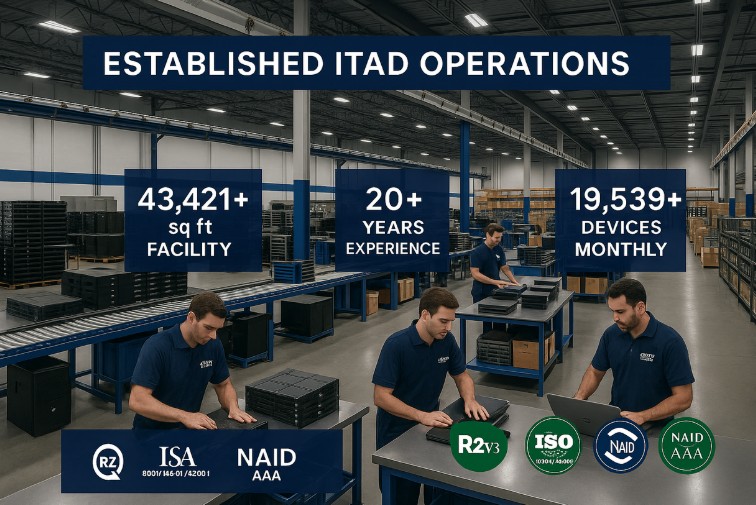Secure, auditable data destruction is a critical business imperative. As enterprises navigate complex regulations and cyber threats, the integrity of their data destruction practices has become critical to risk management and compliance. Improper or unverifiable destruction can expose organizations to severe financial penalties, legal liabilities, reputational damage, and loss of customer trust.
Conducting regular, comprehensive audits is essential to ensure that data destruction procedures are compliant, secure, and effectively uphold data privacy and security. This article provides a practical guide for enterprises seeking to audit their data destruction processes. It outlines key components of an audit-ready program, step-by-step procedures, common challenges and solutions, the role of automation and technology, and how to align with industry standards and certifications.
By implementing robust, proactive audit practices, enterprises can confidently demonstrate compliance, mitigate security risks, and uphold their commitment to responsible data governance. These practices offer assurance that sensitive data is disposed of securely and in accordance with all obligations, safeguarding both valuable information assets and brand reputation.
Understanding the Importance of Data Destruction Audits for Enterprises
Enterprises manage vast quantities of sensitive data—from customer Personally Identifiable Information (PII) and financial records to intellectual property. Secure disposal of this information from end-of-life IT assets is a cornerstone of effective risk management and compliance. A data destruction audit systematically examines an enterprise’s data disposal policies, procedures, and practices to verify that sensitive data is permanently and irretrievably destroyed. Its primary purpose is to provide assurance that improper disposal will not result in data breaches—events that can lead to severe legal, financial, and reputational consequences.
In today’s high-stakes regulatory environment, destruction audits are vital for demonstrating compliance with data protection laws like GDPR, HIPAA, and PCI DSS—each of which require secure, documented data disposal. Regular audits provide credible evidence of meeting these obligations, helping to avoid hefty fines, legal repercussions, or costly investigations.
Robust data destruction audits also build stakeholder trust. Customers, partners, and investors are increasingly concerned about how organizations handle data. Demonstrating a commitment to secure data destruction through regular audits enhances an enterprise’s reputation as a trustworthy custodian of sensitive information, which can be a competitive differentiator.
Finally, the audit process identifies vulnerabilities and inefficiencies within the data destruction program, allowing for continuous improvement to counter evolving threats and new regulatory requirements.
Key Components of a Data Destruction Audit Program
A comprehensive data destruction audit program scrutinizes every aspect of how an enterprise disposes of data-bearing assets. Key components include:
- Policy and Procedure Review: This step examines the enterprise’s documented data destruction policies to ensure they are up to date, thorough, and aligned with applicable regulations such as NIST SP 800-88 Rev. 1. The audit also assesses whether policies are effectively communicated across departments and whether they clearly define roles, data classification schemes, and approved destruction methods for different data types and media.
- Inventory and Asset Tracking Verification: Auditors examine the organization’s crucial, asset inventories and chain-of-custody documentation to confirm an unbroken, verifiable trail for every asset. This ensures no devices are lost or unaccounted for. Often, this includes reconciling physical assets with inventory records and Certificates of Destruction (CoDs).
- Verification of Destruction Methods: This component assesses whether techniques like physical shredding, degaussing, cryptographic erasure, or software-based wiping are performed according to procedures and are effective for the specific media. Auditors may observe destruction processes, inspect equipment logs, and review calibration records. For outsourced destruction, this audit extends to evaluating the vendor’s procedures and currently certifications (e.g., R2 or NAID AAA).
- Personnel Training and Awareness Assessment: This step evaluates the adequacy of training programs for employees involved in data handling and destruction, ensuring they understand their responsibilities and are competent in executing tasks securely.
- Documentation and Reporting Review: Auditors assess whether the enterprise is accurately maintaining all relevant records, including asset inventories, chain-of-custody forms, CoDs, vendor contracts, and incident reports. This provides an auditable trail for compliance and governance.
Step-by-Step Guide to Auditing Your Data Destruction Process
Conducting a successful data destruction audit requires a structured approach.
- Step 1: Define Audit Scope and Objectives
Clearly outline what the audit will cover—departments, locations, asset types, processes. Clarify the objectives, such as compliance verification, vulnerability identification, or evaluating vendor performance. Establish audit criteria based on internal policies, legal requirements, and recognized standards like NIST SP 800-88 Rev. 1. - Step 2: Assemble a Competent Audit Team
Form an audit team with expertise in internal audit, IT security, legal/compliance, and asset management. Consider engaging external auditors for specialized knowledge or objectivity. - Step 3: Gather and Review Relevant Documentation
Collect and review all documentation relevant to your data destruction policies, including: IT asset inventories, chain-of-custody records, CoDs, vendor contracts, training records, and previous audit reports. - Step 4: Conduct Interviews and Observe Processes
Interview key personnel involved in the data destruction lifecycle to assess their understanding of policies and procedures. Directly observe destruction processes, whether on-site or at a vendor’s facility, to identify discrepancies between documentation and actual practices. - Step 5: Perform Physical Inspections and Asset Reconciliation
Inspect secure holding areas for assets awaiting destruction and verify physical security measures such as access controls and surveillance. Reconcile a sample of decommissioned assets against inventory lists and chain-of-custody records to detect discrepancies or missing items. - Step 6: Test and Verify Destruction Method Effectiveness
Where feasible, test the effectiveness of data destruction methods. For software wiping, attempt data recovery on a sample of wiped drives. For physical destruction, verify shred size meets policy requirements. Review equipment logs and maintenance records. - Step 7: Evaluate Third-Party Vendor Management
If destruction is outsourced, review processes for selecting, managing, and overseeing vendors. Examine due diligence, contracts, SLAs, and vendor certifications. - Step 8: Analyze Findings and Identify Gaps
Consolidate audit results and compare them against your established criteria. Document non-conformities, inefficiencies, and weaknesses. Prioritize findings based on risk. - Step 9: Report Findings and Recommendations
Prepare a formal audit report detailing scope, objectives, methodology, findings, and specific, actionable recommendations. - Step 10: Develop and Implement a Corrective Action Plan
Work with stakeholders to create a plan to address identified gaps, assign responsibilities, set timelines, and track implementation. Conduct follow-up reviews for continuous improvement.
Common Challenges in Data Destruction Audits and How to Overcome Them
Enterprises often face challenges in data destruction audits.
- Incomplete or inaccurate asset inventories hinder verification.
Solution: Implement robust IT Asset Management (ITAM) systems and conduct regular internal reconciliations. - Lack of standardized policies and procedures creates compliance gaps.
Solution: Develop clear, comprehensive, centrally managed policies with uniform enforcement and regular training. - Inadequate chain-of-custody documentation makes verifying secure handling difficult.
Solution: Implement stringent protocols with detailed logs at every transfer point. - Insufficient vendor oversight for outsourced destruction is a risk.
Solution: Implement rigorous vendor selection, conduct site audits, define security requirements in contracts, and perform regular reviews. - Keeping pace with evolving technology and regulations requires ongoing effort.
Solution: Assign responsibility for monitoring changes, invest in training, and regularly update policies and audit checklists. - Resource constraints can limit audit thoroughness.
Solution: Secure management commitment, leverage automated tools, focus on high-risk areas, and consider co-sourcing audits.
Proactively addressing these challenges strengthens the audit program, reduces risk exposure, and demonstrates responsible data governance.
Leveraging Technology and Automation in Data Destruction Audits
Modern enterprises can dramatically improve the efficiency, accuracy, and defensibility of their data destruction audits through the strategic use of technology and automation. These tools reduce manual effort, eliminate errors, and provide real-time insights to strengthen audit outcomes.
Automated Asset Discovery and Inventory Management
Real-time asset tracking systems provide real-time, accurate inventories, reducing manual effort or unaccounted-for assets during audits.
Data Destruction Software with Built-in Verification and Reporting
Certified destruction tools often generate tamper-proof reports and Certificates of Sanitization, streamlining verification.
Workflow Automation Platforms for Chain of Custody and Approvals
Automated workflows can automate chain-of-custody tracking, alerts for policy deviations, and disposal approvals, reducing errors.
Audit Management Platforms
Dedicated audit management software streamlines the audit lifecycle, from planning to reporting and corrective action follow-up.
Advanced Analytics and AI-powered Insights
AI tools are emerging to identify anomalies and potential risks in destruction processes.
Security and Compliance Considerations
While automation improves accuracy and speed, tools must be secure, vendor-vetted, and regularly updated to meet compliance obligations.
Strategic implementation of these technologies makes audit programs more robust and efficient, freeing resources for strategic risk management.
Regulatory Compliance and Certifications in Data Destruction Audits
Audits must verify adherence to data protection mandates like GDPR, CCPA/CPRA, and HIPAA, which require secure data erasure. Industry-specific regulations such as GLBA (for financial institutions) and PCI DSS (for payment card data) impose additional documentation that must be documented during the audit process.
Beyond legal mandates, industry standards and certifications like NIST SP 800-88 Rev. 1 provide best practice frameworks. For outsourced destruction, vendor certifications are key. R2 (Responsible Recycling) is a leading global certification that covers data security and chain of custody requirements. OEMSource Inc.’s downstream partners maintain these certifications.
In addition, NAID AAA Certification specifically focuses on secure data destruction operations, ensuring vendors meet strict requirements around process controls, personnel screening, and documentation.
Auditing against these regulations involves reviewing internal policies, observing vendor processes, inspecting CoDs, and verifying vendor credentials. This ensures both legal compliance and industry-recognized alignment with best practices.
Maintaining an up-to-date understanding of this evolving landscape is essential for compliance leaders and auditors alike.
How OEM Source Can Assist with Your Data Destruction Audit Needs
Enterprises aiming to enhance their data destruction audits benefit greatly from partnering with experienced ITAD providers like OEM Source While focused on delivering comprehensive ITAD services, including secure data destruction via vetted R2v3 and e-Stewards certified downstream partners, our expertise inherently supports clients’ audit needs.
We ensure a robust and documented chain of custody, with meticulous tracking from collection to processing. This transparent, end-to-end tracking provides a clear, auditable trail that aligns with data security best practices.
OEM Source ensures data destruction methods meet high industry standards such as NIST SP 800-88, and we provide Certificates of Data Destruction to serve as verifiable proof of secure handling. Our commitment to working only with certified recycling and destruction partners offers added assurance that all data-bearing assets are handled ethically, securely, and in full compliance with applicable regulations.
While OEM Source does not not conduct standalone audits, our audit-friendly processes are detailed and provide documentation and transparency for clients to confidently audit their ITAD program. Partnering with OEM Source means access to secure, compliant, and documented data destruction, simplifying your audit process and helping maintain a strong data security posture.
Ready to strengthen your ITAD program?
Contact OEM Source to learn how our secure, standards-based data destruction solutions can streamline your audit preparation and reinforce your risk management strategy.
Frequently Asked Questions About Data Destruction Audits
What is a data destruction audit, and why is it important for enterprises?
A data destruction audit is a systematic review of an enterprise’s data disposal policies and practices. It ensures that data is irretrievably destroyed in alignment with regulatory and security standards like those from NIST. These audits are crucial for preventing data breaches, demonstrating compliance with regulations like GDPR, HIPAA, PCI DSS, and for maintaining stakeholder trust and brand integrity.
How often should an enterprise conduct a data destruction audit?
At a minimum, data destruction audits should be conducted annually. However, more frequent audits may be needed due to significant changes in processes, technology, vendors, regulations, or after a security incident. Frequency depends on data volume and sensitivity, regulatory demands, and risk appetite.
What are the key areas an auditor will examine during a data destruction audit?
Auditors will examine
- Documented data destruction policies,
- Inventory records
- Chain-of-custody documentation
- Destruction method effectiveness (e.g., shredding, degaussing, software wiping)
- Employee training records
- Vendor management (if outsourced)
- Certificates of Destruction for traceability
What is a Certificate of Destruction, and why is it important for audits?
A Certificate of Destruction (CoD) is an official document confirming specific IT assets and their data have been securely destroyed. CoDs are critical audit evidence, demonstrating compliance and detailing assets, methods, dates, and responsible parties.
How can enterprises ensure their third-party data destruction vendors are compliant and secure?
To evaluate vendor reliability, enterprises should:
- Verify certifications such as R2v3, or NAID AAA
- Request and review security protocols on their transport security, chain-of-custody practices, and destruction methods
- Require detailed CoDs
- Define security expectations and audit rights.
- Conduct regular vendor reviews or site visits
OEM Source works exclusively with certified partners who meet these criteria—ensuring our clients receive secure, transparent, and audit-friendly IT asset disposition services.





